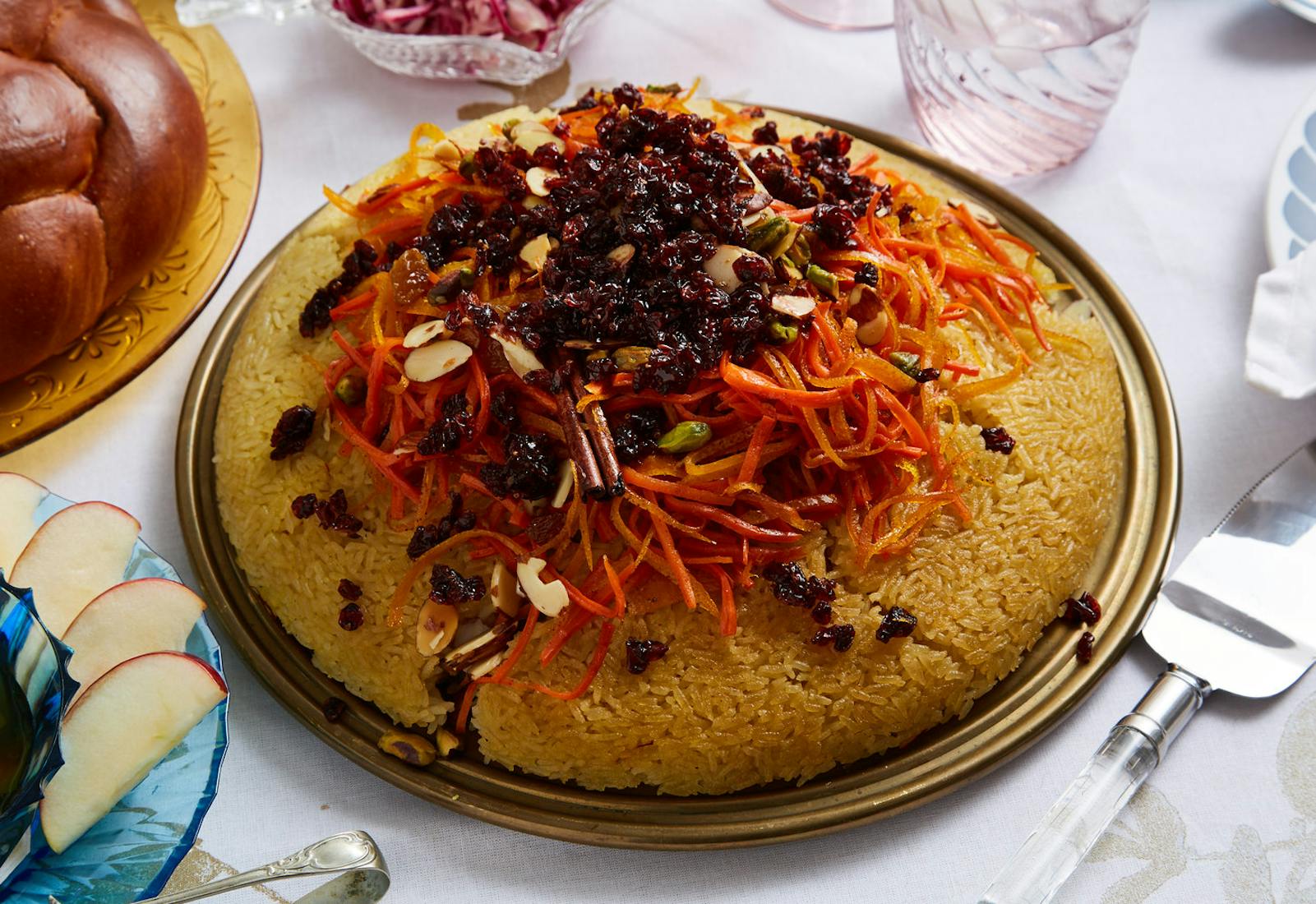Shared by Einat Admony


This elaborate Persian rice with tahdig is a labor of love. It's best to approach it in stages, preparing elements in the days leading up to serving it. Chef and cookbook author Einat Admony explains that the rice can be soaked, blanched, and drained a day in advance. Cool completely before transferring it to a resealable airtight container and store in the fridge until you are ready to make the tahdig.
The caramelized barberries and carrot-orange mixtures can be prepared 1 to 2 days in advance and cooled completely before being stored separately in airtight resealable containers in the fridge. Let each come to room temperature while the tahdig cooks.
And the nut-raisin mixture can be prepared a day in advance and stored in an airtight resealable container at room temperature.
Read more about her family in "Einat Admony’s Rosh Hashanah Table" and try her recipes for veggie tanzia, fresh herb salad, and baked apples with meringue.
Wash the rice to remove its excess starch by placing it in a large bowl and covering it with cool water. Agitate the rice gently with your hand, then pour out the milky water. Repeat until the water runs clear, about 5 times. Cover the rice with cold water, add 2 tablespoons of salt, and allow it to soak for 2-24 hours (soaking yields longer grains of rice). Drain the rice in a fine-mesh strainer and set aside.
Clean the barberries by removing their stems and any grit. Place the barberries in a fine-mesh strainer, and place the strainer in a large bowl of cool water. Agitate the barberries gently and soak for 15-20 minutes (any sand will settle to the bottom). Remove the strainer from the bowl and rinse the barberries. Drain and set aside.
Bring a small saucepan of water to a boil over high heat. Add the julienned orange peel and blanch for 1 minute to remove any bitterness from the peel. Drain, rinse with cold water, and set aside.
Mix the saffron with ¼ cup of the orange blossom water in a small bowl and set aside to steep.
Heat 1 tablespoon of the oil in a large skillet over medium heat. Add the almonds and pistachios, and cook, stirring constantly, until fragrant and beginning to brown, 1-2 minutes. Stir in the raisins, transfer the nut-raisin mixture to a small bowl, and set aside.
Add 1 tablespoon of the oil to the skillet and stir in the barberries, 2 tablespoons of the sugar, and 2 tablespoons of water. Cook, stirring constantly, until the liquid evaporates and the barberries begin to caramelize, 4-5 minutes. (Beware, barberries burn easily!) Transfer to a small bowl and set aside.
Add 2 tablespoons of the oil to the skillet along with the blanched orange peel and julienned carrots. Cook, stirring constantly, until slightly softened, about 2 minutes. Add the remaining 1 cup of sugar, ½ teaspoon of the saffron-infused orange blossom water, the cinnamon stick and the cardamom, and cook, stirring, until the sugar dissolves, about 1 minute. Add ½ cup of water and bring the mixture to a boil over medium-high heat. Cook until the carrot-orange mixture is lightly caramelized and the liquid is syrupy, 8 to 10 minutes. Drain, reserving the syrup (about ¾ cup), and set aside.
Bring 10 cups of water with 2 tablespoons of salt to a boil in a large nonstick pot or deep skillet over high heat. Add the drained rice to the pot along with the remaining tablespoon of orange blossom water. Boil briskly for 6 to 10 minutes until the rice softens slightly and has risen to the surface. Drain the rice in a large, fine-mesh strainer and rinse with 2 cups of cold water.
To make the tahdig: Whisk together ½ cup of the oil, 2 tablespoons of water, ½ teaspoon of the saffron-orange blossom water, and 2 cups of the cooked rice in a medium bowl. Spread the mixture evenly over the bottom of the pot. Give the pot a shake to even out the base.
Gently spoon the remaining rice on top of the saffron-rice mixture, gradually shaping the rice into a pyramid-shaped mound. (This shape leaves room for the rice grains to expand and enlarge.) Cover the rice and cook for 10 minutes over medium-high heat.
Combine the remaining oil and orange-saffron blossom water with the reserved carrot-orange syrup in a measuring cup and drizzle it evenly over the rice. Wrap the lid of the pot with a clean dish towel and cover the pot firmly to prevent steam from escaping. Cook over medium-low heat until the bottom layer of rice is crisp and golden brown, about 1 hour.
Remove the pot from heat. Allow it to cool on a damp dish towel on a heat-proof surface for 2 to 3 minutes without opening the lid. (This helps to free the crust from the bottom of the pot.) Remove the lid, then loosen the edges of the rice with an off-set spatula.
Place a large serving plate over the top of the rice and, firmly gripping the plate to the pot or skillet with oven mitts, carefully invert the rice onto the plate so that the browned crust is on top. Top the tah-dig with the caramelized carrot mixture, caramelized barberries, and the nut-raisin mixture. Serve immediately. Leftover tahdig can be stored in an airtight container in the refrigerator for 5 days.